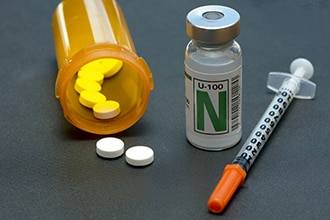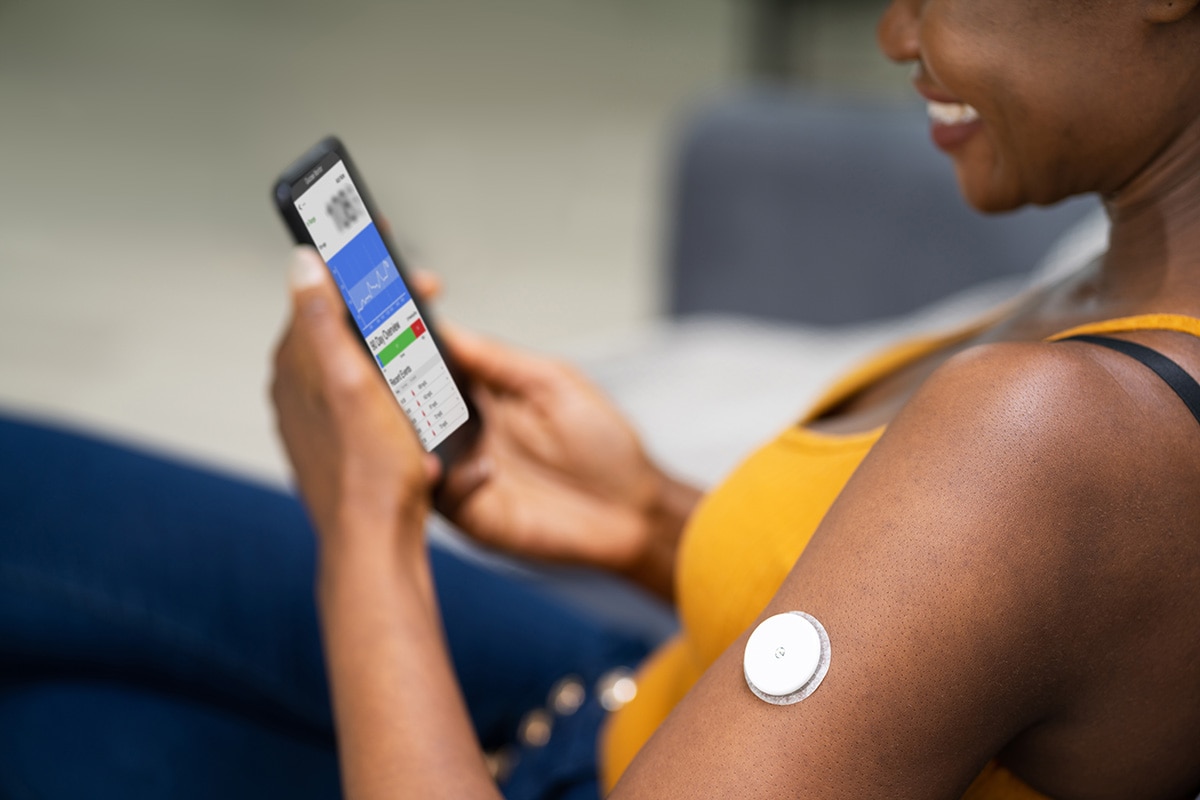Low Blood Glucose (Hypoglycemia)
On this page:
- What is low blood glucose?
- How common is low blood glucose?
- Who is more likely to develop low blood glucose?
- What are the symptoms of low blood glucose?
- What are the complications of low blood glucose?
- What causes low blood glucose in people with diabetes?
- How can I prevent low blood glucose if I have diabetes?
- How do I treat low blood glucose?
- What if I have severe low blood glucose and can’t treat myself?
- Clinical Trials for Low Blood Glucose
What is low blood glucose?
Low blood glucose, also called low blood sugar or hypoglycemia, occurs when the level of glucose in your blood drops below what is healthy for you. For many people with diabetes, this means a blood glucose reading lower than 70 milligrams per deciliter (mg/dL).1 Your number might be different, so check with your doctor or health care team to find out what blood glucose level is low for you.
How common is low blood glucose?
Low blood glucose is common among people with type 1 diabetes and among people with type 2 diabetes who take insulin or some other diabetes medicines. In a large global study of people with diabetes who take insulin, 4 in 5 people with type 1 diabetes and nearly half of those with type 2 diabetes reported a low blood sugar event at least once over a 4-week period.2
Severely low blood glucose, defined as when your blood glucose level drops so low you can’t treat it yourself, is less common. Among U.S. adults with diabetes who take insulin or some diabetes medicines that help the pancreas release insulin into the blood, 2 in 100 may develop severely low blood glucose each year.3
Who is more likely to develop low blood glucose?
You are more likely to develop low blood glucose if you4
- have type 1 diabetes
- take insulin or some other diabetes medicines
- are age 65 or older5
- had low blood glucose before
- have other health problems, such as kidney disease, heart disease, or cognitive impairment
What are the symptoms of low blood glucose?
Symptoms of low blood glucose tend to come on quickly and can vary from person to person. As Table 1 below shows, symptoms can range from mild to severe.
Table 1. Symptoms of low blood glucose6
| Mild-to-Moderate | Severe |
|---|---|
|
If your blood glucose level is low, you may feel
|
If your blood glucose level is very low, your brain may stop working as it should. You may
Severe hypoglycemia is dangerous and needs to be treated right away. |
Low blood glucose during sleep
Your blood glucose level can drop while you sleep and stay low for several hours, causing serious problems.7 Symptoms of low blood glucose while you sleep can include
- crying out or having nightmares
- sweating enough to make your pajamas or sheets damp
- feeling tired, irritable, or confused after waking up
Although you may not wake up or notice any symptoms, low blood glucose can interfere with your sleep, which may affect your quality of life, mood, and ability to work. Having low blood glucose during sleep can also make you less likely to notice and respond to symptoms of low blood glucose during the day.
What are the complications of low blood glucose?
Mild-to-moderate low blood glucose can be easily treated. But severely low blood glucose can cause serious complications, including passing out, coma, or death.
Repeated episodes of low blood glucose can lead to
- high blood glucose levels, if worry or fear of low blood glucose keeps you from taking the medicines you need to manage your diabetes8
- hypoglycemia unawareness, a condition in which you don’t notice any symptoms of low blood glucose until your blood glucose level has dropped very low
What causes low blood glucose in people with diabetes?
Low blood glucose levels can be a side effect of insulin or some other medicines that help your pancreas release insulin into your blood. Taking these can lower your blood glucose level.
 Insulin and some other diabetes medicines can lower your blood glucose level.
Insulin and some other diabetes medicines can lower your blood glucose level.Two types of diabetes pills can cause low blood glucose
- sulfonylureas, usually taken once or twice per day, which increase insulin over several hours
- meglitinides, taken before meals to promote a short-term increase in insulin
The following may also lower your blood glucose level
- Not eating or drinking enough carbohydrates (carbs). When you eat foods or drink beverages that contain carbohydrates, your digestive system breaks down the sugars and starches into glucose. Glucose then enters your bloodstream and raises your blood glucose level. If you don’t eat enough carbohydrates or skip or delay any meals, your blood glucose level could drop lower than what is healthy for you.
- Fasting. Continuing to take medicines that lower your glucose level while fasting for a medical procedure or for other purposes can also increase the risk for low blood glucose.
- Increasing physical activity. Increasing your physical activity level beyond your usual routine can lower your blood glucose level for up to 24 hours after the activity. Learn more about diabetes, eating, and physical activity.
- Drinking too much alcohol without enough food. Alcohol makes it harder for your body to keep your blood glucose level steady, especially if you haven’t eaten in a while. Alcohol can also keep you from feeling the first symptoms of low blood glucose, which can lead to severe symptoms.
- Being sick. When you’re sick, you may not be able to eat as much or keep food down, which can lower blood glucose.
How can I prevent low blood glucose if I have diabetes?
If you take insulin or other medicines that lower blood glucose, the following actions may help you prevent low blood glucose levels.
- Ask your doctor or health care team how to check your blood glucose level. The most common way to do so is by using a blood glucose meter. If you have hypoglycemia unawareness or have low blood glucose often, a continuous glucose monitor (CGM) may be a good option. The CGM measures your blood glucose level at regular times and can sound an alarm if it drops below your target range.
- Make sure your regular eating plan includes meals, snacks, and beverages with enough carbohydrates to help keep your blood glucose level in your target range. Carry a source of fast-acting carbohydrate, such as glucose tablets or a juice box, with you. Also, if you drink alcoholic beverages, it’s safer to eat some food at the same time.
- Be safe during exercise or physical activity. Physical activity can lower your blood glucose during the activity and for hours afterward. You may need to check your blood glucose before, during, and after physical activity and adjust your medicine or carbohydrate intake to prevent low blood glucose. For example, you might eat a snack before physical activity to prevent low blood glucose.
- Work with your doctor or health care team to prevent low blood glucose. Ask your team if any of your diabetes medicines can cause low blood glucose and how you can prevent and treat symptoms. Work with your doctor or health care team to adjust your diabetes management plan as needed.
 Some CGMs let you track your blood glucose levels using a small sensor attached to your arm or abdomen and view the information on your smartphone.
Some CGMs let you track your blood glucose levels using a small sensor attached to your arm or abdomen and view the information on your smartphone.How do I treat low blood glucose?
 If your blood glucose is below your target, take 15 to 20 grams of glucose or carbohydrates right away.
If your blood glucose is below your target, take 15 to 20 grams of glucose or carbohydrates right away.
If you begin to feel one or more symptoms of low blood glucose, check your blood glucose level. If your blood glucose level is below your target or less than 70 mg/dL, follow these steps
- Eat or drink 15 to 20 grams of glucose or carbohydrates right away. Examples include
- four glucose tablets or one tube of glucose gel.
- 1/2 cup (4 ounces) of fruit juice—not low-calorie or reduced-sugar juice. If you have kidney disease, don’t drink orange juice because it has a lot of potassium. Apple, grape, or cranberry juice are good options.
- 1/2 can (4 to 6 ounces) of soda—not low-calorie or reduced-sugar soda.
- 1 tablespoon of sugar, honey, or corn syrup.
- Wait 15 minutes and check your blood glucose level again. If your glucose level is still low, eat or drink another 15 to 20 grams of glucose or carbohydrates.
- Check your blood glucose level again after another 15 minutes. Repeat these steps until your glucose level is back to your target range.
- If your next meal is more than 1 hour away, have a snack to keep your blood glucose level within a range that is healthy for you. Try crackers or a piece of fruit.
Treating low blood glucose if you take medicines that slow down digestion
Some diabetes medicines slow down the digestion of carbohydrates to keep blood glucose levels from rising too high after you eat. If you develop low blood glucose while taking these medicines, you will need to take glucose tablets or glucose gel right away. Eating or drinking other sources of carbohydrates won’t raise your blood glucose level quickly enough.
What if I have severe low blood glucose and can’t treat myself?
Glucagon—a hormone that raises blood glucose levels—is the best way to treat severely low blood glucose. Available as an injection or a nasal spray, glucagon will quickly raise your blood glucose level. Your doctor can prescribe you a glucagon kit for use in case of an emergency.
If your blood glucose level drops very low, you won’t be able to treat it by yourself. Be prepared to address severely low blood glucose by
- talking with your doctor or health care team about when and how to use a glucagon emergency kit. If you have an emergency kit, regularly check the date on the package to make sure it hasn’t expired.
- teaching your family, friends, and coworkers when and how to give you glucagon. Tell them to call 911 right away after giving you glucagon or if you don’t have a glucagon emergency kit with you.
- wearing a medical alert identification bracelet or pendant. A medical alert ID tells other people that you have diabetes and need care right away. Getting prompt care can help prevent the serious problems that low blood glucose levels can cause.
Clinical Trials for Low Blood Glucose
The NIDDK conducts and supports clinical trials in many diseases and conditions, including diabetes. The trials look to find new ways to prevent, detect, or treat disease and improve quality of life.
What are clinical trials for low blood glucose?
Clinical trials—and other types of clinical studies—are part of medical research and involve people like you. When you volunteer to take part in a clinical study, you help doctors and researchers learn more about disease and improve health care for people in the future.
Researchers are studying many aspects of low blood glucose levels in diabetes, such as
- how to diagnose and treat low blood glucose among people with diabetes
- medicines that can treat symptoms of low blood glucose in people with hypoglycemia unawareness
- educational approaches to reduce fear of low blood glucose, which can make it harder for you to control your diabetes
Find out if clinical studies are right for you.
Watch a video of NIDDK Director Dr. Griffin P. Rodgers explaining the importance of participating in clinical trials.
What clinical studies for low blood glucose are looking for participants?
You can view a filtered list of clinical studies on low blood glucose that are federally funded, open, and recruiting at ClinicalTrials.gov. You can expand or narrow the list to include clinical studies from industry, universities, and individuals; however, the National Institutes of Health does not review these studies and cannot ensure they are safe. Always talk with your health care provider before you participate in a clinical study.
References
This content is provided as a service of the National Institute of Diabetes and Digestive and Kidney Diseases
(NIDDK), part of the National Institutes of Health. NIDDK translates and disseminates research findings to increase knowledge and understanding about health and disease among patients, health professionals, and the public. Content produced by NIDDK is carefully reviewed by NIDDK scientists and other experts.
The NIDDK would like to thank:
Martha Funnell, M.S., R.N., C.D.E., University of Michigan Medical School

